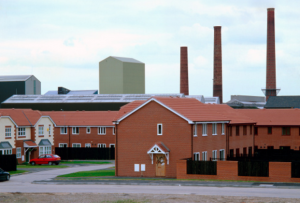


Residential development adjacent to industrial uses

In spite of the obvious benefits of keeping dwellings well away from industrial uses, increasing pressure on land and the drive for more housing has meant that residential development close to industrial uses is becoming ever more common.
Local planning authorities (LPAs) often resist such schemes on noise grounds. Their argument being that the legal onus (under the Environmental Protection Act 1990 (EPA)) would be on the industrial use to reduce noise should future residents complain about industrial noise once they have moved in. This can place unreasonable constraints and/or financial burdens on industry and in some cases has resulted in closure and the loss of employment.
However, more recently there have been signs from government that residents moving into developments near industrial uses may be expected to accept that some noise is inevitable. This is reflected in the softening of planning guidance regarding the definition of what constitutes a statutory nuisance, which in effect, reduces the requirement for local authorities to take legal action under the EPA (see http://planningguidance.communities.gov.uk/blog/guidance/noise/noise-guidance/ para 007).
Moving in the opposite direction, a recently revised British Standard (BS4142:2014) has, for the first time, required that an assessment be made on dwellings proposed near existing industrial uses. The problem with BS4142 is that it only assesses noise external to a proposed dwelling and therefore does not take into account any mitigation that can be incorporated into the façade (eg high performance glazing or mechanical ventilation etc). As a result, most proposed dwellings proposed near industrial uses will fail to achieve a satisfactory BS4142 rating, which provides support for any LPA wishing to refuse such an application.
Our experience is that a reasonable compromise can often be negotiated with LPAs based on a combination of layout/landscaping together with façade mitigation designed to ensure that internal noise levels achieve suitable standards (typically as set out in BS8233:2014). Typical mitigation strategies are briefly discussed below:
1) Site layout
Whilst it is good practice to keep dwellings as far as possible from the boundary with an industrial site, noise does not reduce quickly with increasing distance. It is therefore normally not practical to rely on distance alone to reduce the industrial noise. However, all else being equal, placing playgrounds or public amenity land on the boundary is beneficial acoustically, especially when incorporating an appropriately designed acoustic barrier/bund on the boundary line.
Of potentially more benefit, is locating terraced houses or flats on the boundary to act as an acoustic barrier for the rest of the site. This requires careful façade and amenity space design but can help to maximise land usage.
2) Landscaping
It is a common misconception that trees/bushes act as acoustic barriers. In fact, bands of trees/bushes up to around 25m deep have no significant acoustic properties. However, the visual screening they provide can often help residents to believe that the noise is less and so they do have a psychological value. An effective acoustic barrier needs to be imperforate and of sufficient surface mass so that the sound travelling through it is insignificant compared with the sound travelling over the top (typically a minimum surface mass of 10-12kg/m2 is required). Tall wooden barriers can be effective but can also be visually dominating. Earth bunds are very effective, but can take up too much space, and so a small bund combined with a smaller wooden barrier on top is often adopted.
3) Façade design
The weakest parts acoustically of a typical dwelling are the glazing and the ventilation. Both of these can generally be specified to achieve whatever is required to achieve satisfactory internal noise levels. Typically a noise survey will be carried out to quantify the industrial noise and then the glazing and ventilation will be specified accordingly. Matters can be complicated by solar gain and overheating issues, but our experience is that façade design is normally fairly straightforward.
4) Negotiation with the industrial user
Often it is tempting to try and reduce the noise at source through negotiation with the industrial user. Whilst this can be effective, especially if the noise is caused by a well-defined source that is readily mitigated or replaced (eg an old compressor or fan, where replacement would be much cheaper than noise control to the residential scheme and where the prospect of new machinery would be a tempting incentive for the industrial user to co-operate). However, for large industrial sites that contain many noise sources or where the noise source is not immediately apparent (eg noise breakout through large industrial sheds) our experience is that mitigating the industrial noise is often problematic both technically and in terms of logistics. Clients also are legitimately concerned than once they become dependent upon the industrial user their negotiating position becomes weaker.
As with many aspects of acoustics, early integration of an acoustician into the planning team is essential when considering a residential development near an existing industrial use.








